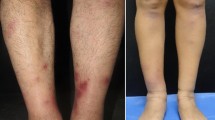Summary
The amount of bullous pemphigoid antigen (BPA) in normal human skin on different areas of the body and in bodies of different ages was determined by making endpoint titer estimations using the indirect immunofluorescence technique. Two sera with bullous pemphigoid antibodies were tested with 36 specimens of normal human skin from six cadavers. The greatest expression of BPA was found in plantar sites, whereas the lowest endpoint titers were seen in flexural arm biopsy specimens. Age-dependent differences in BPA expression were detected as well. The oldest individuals tested produced the highest endpoint titers in contrast to the lowest endpoint titers in the youngest. This study suggests that the amount of BPA depends not only on the body region where the biopsy specimen is taken but also on the age of the donor. This is important to know in connection with indirect immunofluorescence assays for BP antibodies on human skin.
Similar content being viewed by others
References
Beutner EH, Chorzelski TP, Bean SF, Jordon RE (1973) Immunopathology of the skin: labeled antibody studies. Dowden Hutchinson Ross, Stroudsburg USA
Beutner EH, Jordon RE, Chorzelski TP (1968) The immunopathology of pemphigus and bullous pemphigoid. J Invest Dermatol 51:63–80
Bird P, Friedman PS, Ling N, Bird AG, Thompson RA (1986) Subclass distribution of IgG autoantibodies in bullous pemphigoid. J Invest Dermatol 86:21–25
Chorzelski TP, Beutner EH (1972) Factors contributing to occasional failures in the laboratory diagnosis of bullous pemphigoid by indirect immunofluorescence. Br J Dermatol 86:111–117
Chorzelski TP, Jablonska S, Blaszczyk M, Jarzabek M (1968) Autoantibodies in pemphigoid. Dermatologica 136:325–334
Fine JD, Smith LT, Holbrook KA, Katz SI (1984) The appearance of four basement membrane zone antigens in developing human fetal skin. J Invest Dermatol 83:66–69
Furue M, Iwata M, Tamaki K, Ishibashi Y (1986) Anatomical distribution and immunological characteristics of epidermolysis bullosa acquisita antigen and bullous pemphigoid antigen. Br J Dermatol 114:651–659
Gammon WR, Briggaman RA, Inman AO, Queen LL, Wheeler CE (1984) Differentiating anti-lamina lucida and anti-sublamina densa anti-BMZ antibodies by indirect immunofluorescence on 1.0 M sodium chloride-separated skin. J Invest Dermatol 82:139–144
Gammon WR, Alfred O, Imman MS, Wheeler CE Jr (1984) Differences in complement-dependent chemotactic activity generated by bullous pemphigoid and epidermolysis bullosa acquisita immune complexes. Demonstration of leukocyte attachment and organ culture methods. J Invest Dermatol 83:57–61
Goldberg DJ, Sabolinski M, Bystryn JC (1984) Regional variation in the expression of bullous pemphigoid antigen and location of lesions in bullous pemphigoid. J Invest Dermatol 82:326–328
Holubar K, Wolff K, Konrad K, Beutner EH (1975) Ultrastructural localization of immunoglobulins in bullous pemphigoid skin. J Invest Dermatol 64:220–227
Johnson GD, de C Nogueira Aranjo GM (1981) A simple method for reducing the fading of immunofluorescence. J Immunol Methods 43:349–350
Mutasim DF, Grant JA, Diaz LA, Patel HP (1987) Linear immunofluorescence staining of the cutaneous basement membrane zone produced by pemphigoid antibodies: the result of hemidesmosome staining. J Am Acad Dermatol 16:75–82
Mutasim DF, Takahashi Y, Ramzy LS, Anhalt GJ, Patel HP, Diaz LA (1985) A pool of bullous pemphigoid antigen(s) is intracellular and associated with the basal cell cytoskeleton-hemidesmosome complex. J Invest Dermatol 84:47–53
Sams WM, Schur PM (1972) Studies of the antibodies in pemphigoid and pemphigus. J Lab Clin Med 82:249–254
Schaumburg-Lever G, Rule RA, Schmidt-Ullrich B, Lever WF (1975) Ultrastructural localization of in vivo bound immunoglobulins in bullous pemphigoid: a preliminary report. J Invest Dermatol 64:47–49
Stanley JR, Hawley-Nelson P, Yuspa SH, Shevach EM, Katz SI (1981) Characterization of bullous pemphigoid antigen: a unique basement membrane protein of stratified squamous epithelia. Cell 24:897–903
Weigand DA (1985) Effect of anatomic region on immunofluorescence diagnosis of bullous pemphigoid. J Am Acad Dermatol 12:274–278
Woodley DT (1987) Importance of the dermal-epidermal junction and recent advances. Dermatologica 174:1–10
Yamasaki Y, Nishikawa T (1983) Ultrastructural localization of in vitro binding sites of circulating antibasement membrane zone antibodies in bullous pemphigoid. Acta Derm Venereol (Stockh) 63:501–506
Zhu XJ, Bystryn JC (1983) Heterogeneity of pemphigoid antigens. J Invest Dermatol 80:16–20
Author information
Authors and Affiliations
Rights and permissions
About this article
Cite this article
Hamm, G., Wozniak, K.D. Bullous pemphigoid antigen concentration in normal human skin in relation to body area and age. Arch Dermatol Res 280, 416–419 (1988). https://doi.org/10.1007/BF00429980
Received:
Issue Date:
DOI: https://doi.org/10.1007/BF00429980




